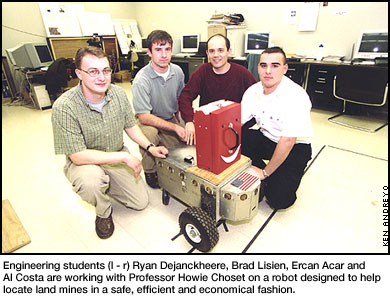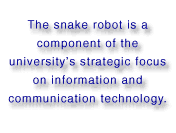|
|
||
|
|
|
 Mechanical Engineer Gets Federal Grant; His Snake Robot Will Assess Waste Sites
Howie Choset, an assistant professor of
mechanical engineering, has received an $800,000 grant from the Department of
Energy to build probes that can help assess contamination at waste storage sites. He'll use the funding over the next three years to redesign and reconfigure his snake robots to do the task, helping energy officials reach remote locations throughout North America.
Snake robots are a new type of robot, known also as hyper-redundant mechanisms. As the name implies, these robots possess multiple actuated joints enabling them to provide users with wider mobility in often very cramped settings.
"Essentially, the snake robot is very small, but flexible and strong," Choset said.
In his lab, deep in the interior of Hamerschlag Hall, Choset and a team
of talented Carnegie Mellon engineering students work to create the perfect snake robot configuration.
"We have been concentrating our efforts on developing compact joint designs," Choset said.
Because of the snake-like structure, the robot also is ideal for search and rescue operations. Choset said the snake must be able to crawl through rubble and wind around a variety of internal obstacles
with ease and speed.
"The snake robot operates very much like an elephant trunk when it is used for search and rescue operations," Choset explained.
Another important part of his research involves developing robots to seek out land mines. His demining robot work develops key technologies for mapping out areas where lethal mines are present.
"Searching for land mines is a dangerous and expensive task, but we think our demining robot will help defray costs and save lives," Choset said.
The goal of the demining robot project is to develop intelligent algorithms which guarantee that the robot maps out the highest concentration of targets.
Still, one of the biggest targets and goals for Choset is what he calls "Educational Robotics."
"I want my students to get hands-on exposure about how robots work, and
we now have classes that help them do just that," he said.
Chriss Swaney
|
|
This Issue's Headlines || Carnegie Mellon News Home || Carnegie Mellon Home |
||
 "This is a great project because it gives us the opportunity to demonstrate the varied uses for snake robots," said Choset, whose first generation snake robot was designed to inspect the underpinnings of bridges.
"This is a great project because it gives us the opportunity to demonstrate the varied uses for snake robots," said Choset, whose first generation snake robot was designed to inspect the underpinnings of bridges.